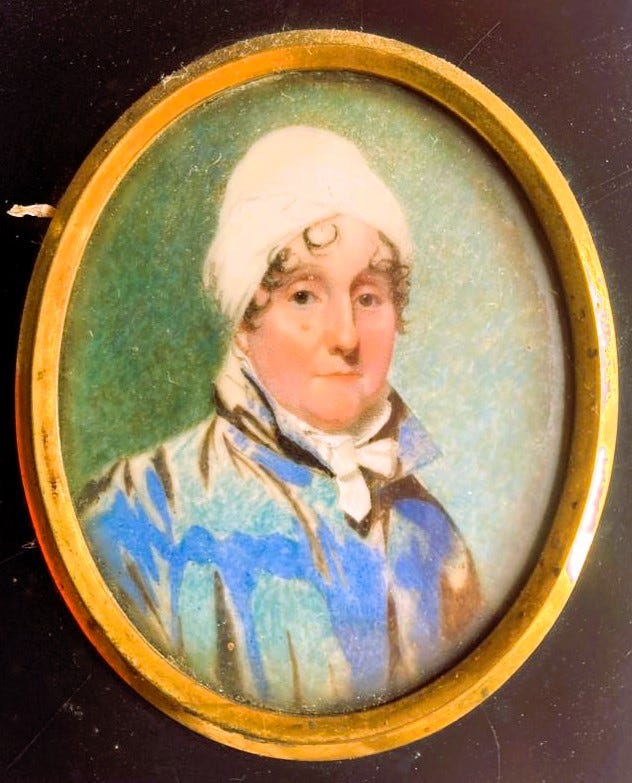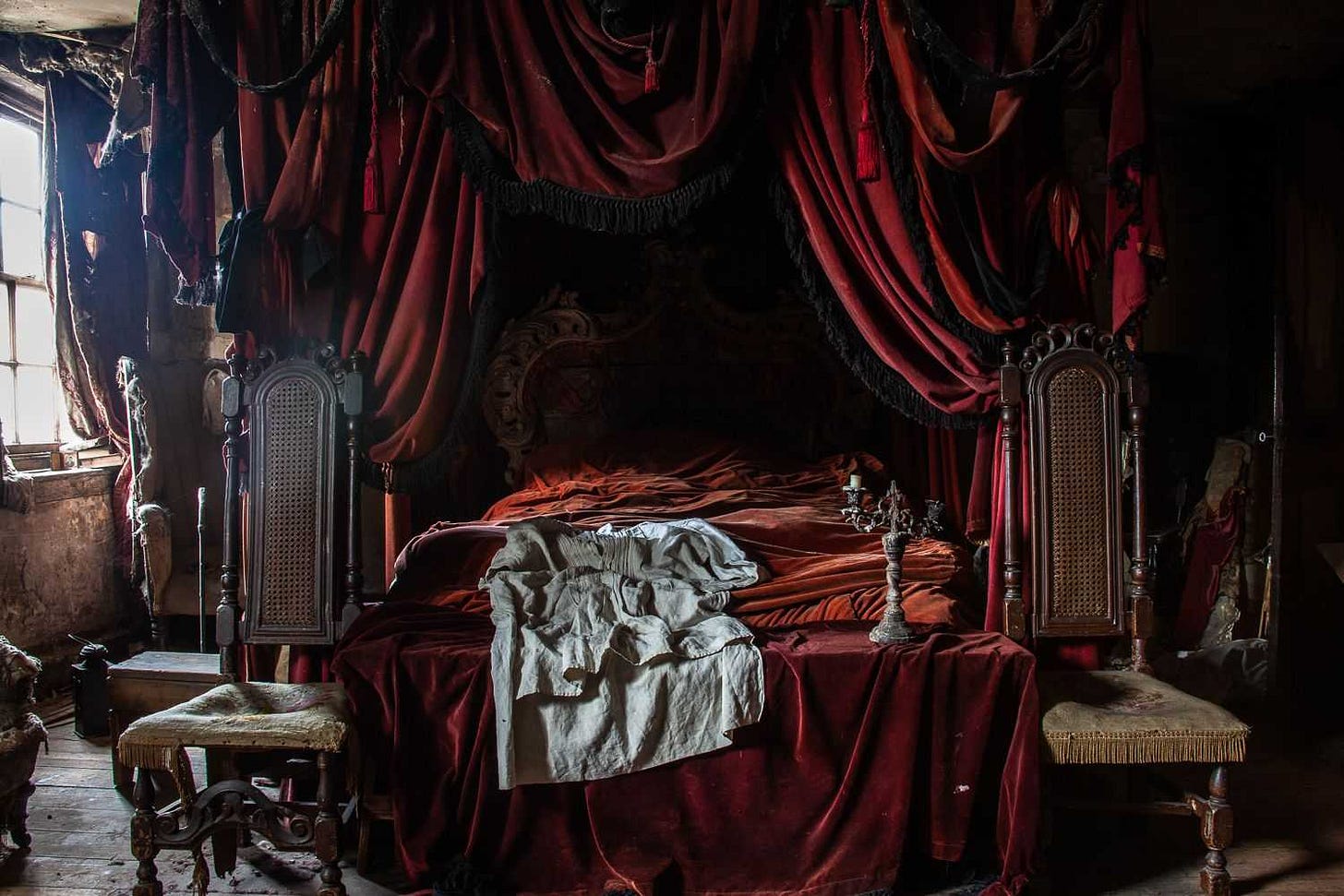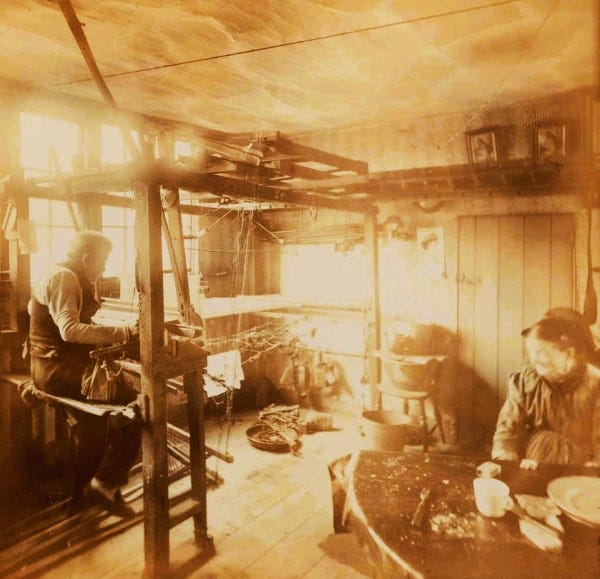I stumbled across a photograph recently and it has been on my mind this week. Titled ‘Huguenot weavers in Spitalfields, 1895’, the scene is domestic, and speaks of back-breaking work and poverty. It is not what I associate with the Huguenot silk-weaving industry in Spitalfields. I think of the magnificent houses, the wealth and their skill in producing breath-taking silks. So, curiosity to the fore, I delved deeper, and this week I share some of my finds, looking at the lives of the exiled French Huguenot weavers, specifically at the end of the 19th century, when their fortunes had waned…and that photograph.
I can trace my paternal family tree back to the Protestant French Huguenot refugees who settled in Bath in the 17th century. I don't know their profession, but most of the fleeing Huguenots who arrived in Bath (usually via Bristol) are recorded as being silk-merchants, weavers, and spinners. Certainly that side of my family seems to have had a sustained love for textiles, carpets and embroidery, so maybe it is in our blood?
My Huguenot ancestor
After the Revocation of the Edict of Nantes in 1685, the majority of the 15,000 French Huguenot refugees made their way to Norwich, or Spitalfields in London, where they formed a community that settled and flourished. These refugees are credited with reviving the English textile industry. There was already a fledgling silk industry in Spitalfields, but the arrival of experienced silk weavers elevated the English silk industry to a new level of craftsmanship. However, after more than a century of successful trading, by the early 19th century the industry was in terminal decline, echoed in the poverty and slum status of Spitalfields itself.
I have three offerings that shed light on this moment in time, when the last weavers were clinging on to a dying trade. These three items illuminate this story and I hope are of interest to fellow textile magpies and historians. There are also references at the end of this article for those who wish to dive deeper.
This week’s curios and curiosities from Precious Tatters
The first is a video entitled ‘Victorian London's Slums of Silk – Spitalfields and its Wretched Weavers’. Despite a melodramatic narration (and maybe skip the first few minutes of the total 18 minutes), it is a delight of archival material and some particularly good early photographs of weavers, and contemporaneous 19th century commentary.
The second offering is a suggestion. Go and visit Dennis Severs' House . Just go… It’s an astonishing Spitalfields house, restored and re-imagined as a wealthy Huguenot home through the ages of prosperity and decline. It’s like no visitor experience you have had before - eccentric and evocative. Take the Silent Tour.
Dennis Severs’ House, 18 Folgate Street, Spitalfields. A Huguenot home through the ages
The third offering is the single photograph that initiated this writing. It is somewhat ghostly and indistinct, but so evocative that it has been on my mind for some time. It is taken long after the heyday of the Huguenots, and shows the last remnants of the glorious industry that had brought prosperity to Spitalfields and when French names hung over the doors of fine buildings.
Huguenot Weavers, Spitalfields, 1895
The following is an extract from an article by Charles Dickens, ‘Spitalfields’, in ‘Household Words’, 1851 [full article and ref below]. The article describes the local conditions for silk traders and weavers in Spitalfields, the Ragged schools and the demise of the silk industry. This excerpt could describe this very scene in the image above, and its impoverished circumstances.
“Up a dark narrow winding public stair … into a room where there are four looms; one idle, three at work. A wan thin eager-eyed man, weaving in his shirt and trousers, stops the jarring of his loom. He is the master of the place…"Good day!" "Good day! " Passing his hand over his rough chin, and feeling his lean throat. "We are walking through Spitalfields, being interested in the place. Will you allow us to look at your work?" "Oh! certainly." "It is very beautiful. Black velvet?" "Yes. Every time I throw the shuttle, I cut out this wire, as you see, and put it in again so!" Jarring and clashing at the loom, and glancing at us with his eager eyes. "It is slow work?" "Very slow." With a hard dry cough, and the glance. "And hard work?" "Very hard." With the cough again. After a while, he once more stops, perceiving that we really are interested, and says, laying his hand upon his hollow breast and speaking in an unusually loud voice, being used to speak through the clashing of the loom: "It tries the chest, you see, leaning for'ard like this for fifteen or sixteen hours at a stretch." "Do you work so long at a time?" "Glad to do it when I can get it to do. A day's work like that, is worth a matter of three shillings." "Eighteen shillings a week?" "Ah! But it ain't always eighteen shillings a week. I don't always get it, remember! One week with another, I hardly get more than ten, or ten-and-six." […] "Is that your wife at the other loom?" "That's my wife. She's making a commoner sort of work, for bonnets and that." Again his loom clashes and jars, and he leans forward over his toil. […] The room is unwholesome, close, and dirty. Through one part of it the staircase comes up in a bulk, and roughly partitions off a corner. In that corner are the bedstead and the fireplace, a table, a chair or two, a kettle, a tub of water, a little crockery. The looms claim all the superior space and have it. Like grim enchanters who provide the family with their scant food, they must be propitiated with the best accommodation. […] The children sleep at night between the legs of the monsters, who deafen their worst cries with their whirr and rattle, and who roar the same tune to them when they die. Come to the mother's loom. "Have you any other children besides these?" "I have had eight. I have six alive." "Did we see any of them, just now, at the Ragged School? O yes! You saw four of mine at the Ragged School!" She looks up, quite bright about it. She has a mother's pride in it and is not ashamed of the name: she, working for her bread, not begging it, not in the least. She has stopped her loom for the moment. So has her husband. So has the young man. "Weaver's children are born in the weaver's room," says the husband, with a nod at the bedstead. "Nursed there, brought up there get sick or well there and die there."
The silk trade in general was volatile during the 19th century; the French revolution caused both a glut on the market then later a huge demand, and during this time the English silk market was buffeted by great changes in price, as Dickens’ reporter says,
“…the French goods being exhausted, ours came into play. Indeed, during that year the British manufacturer was in a position to defy competition." "The French had not recovered themselves?" "Not only that but we had bought nearly all their raw silk, and they were actually obliged to buy it back from us at advances of from twenty to fifty per cent.! From that time prices advanced here, and work kept on increasing, so that, during most of last year, Spitalfields was busy." "A glut of stock has been again the consequence?" "Yes; and what with that and the advancing price of raw silk,* I have within the last fortnight been compelled to discharge one hundred hands."
I found one tiny fragment of information, poignant and distressing, that I am not sure has been mentioned before in connection with Spitalfields weavers and the New Poor Law (the “relief” provided changed from a payment in cash to board and lodging at a Union workhouse in return for labour ). Our narrator tells us,
“Work in the stone-yard was the test of all able-bodied applicants for relief. Now, the weaver's hands are soft and delicate, and must be so for his work. No matter. The weaver wanting relief, must work in the stone-yard with the rest. So, the Union blistered his hands before it relieved him, and incapacitated him from doing his work when he could get it.”
By the early to mid-19th century hand labour was being superseded by machine work. Indian and Chinese silks were cheaper and more readily available. A final nail in the coffin was the complete removal of import tax in French silks in 1860. Industrial action had failed and famine set it, and, ultimately, laws around cheap import and export of cloth, and changes in fashion saw the demise of textile production in Spitalfields.
“The looms are silent have been moved off long ago. The click of shuttle and the whirr of wheel are heard no more, even in the few remaining poor and sordid streets, where the long leaded casements of the upper windows show that the houses were once the workshops for silk and velvet, and a ruined dormer, or a mouldering pigeon-house upon the roof, suggest the time when the whole district represented an industry that even then was deeply marked with the signs of decay.” (‘Huguenots in Spitalfields’ - 2nd May, 1885, The Graphic)
References:
Charles Dickens’ article ‘Spitalfields’ - ‘Household Words’ April 5th 1851
‘Huguenots in Spitalfields’ - 2nd May, 1885, The Graphic
Spitalfields Weavers - London's Luddites? PDF







A very interesting and informative dip into the lives of the refugee weevers.
Thank you! I’m glad you enjoyed it.